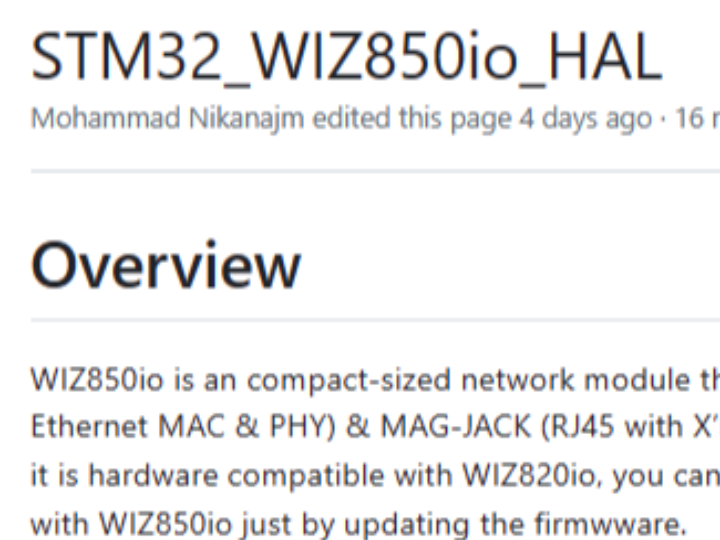STM32_WIZ850io_HAL
This page is a WIKI page for STM32_WIZ850io_HAL written by GitMasterNikanjam. This page is part of STM32CubeF0 HAL Driver and provides HAL-LL Drivers.

WIZ850io is an compact-sized network module that includes W5500(TCP/IP & Ethernet MAC & PHY) & MAG-JACK (RJ45 with X’FMR) with other glue logics. As it is hardware compatible with WIZ820io, you can easily replace the WIZ820io with WIZ850io just by updating the firmware.
WIZnet IOLibrary: A Comprehensive Toolkit for WIZnet Device Networking
The WIZnet IOLibrary is a collection of libraries developed by WIZnet specifically for their devices, particularly their Internet of Things (IoT) modules and chips. These devices often feature embedded Ethernet controllers and are widely employed to establish network connectivity in various embedded systems.
The iolibrary.h header file, an integral part of the IOLibrary, provides declarations and definitions essential for interfacing with WIZnet devices. It typically offers functions and structures that facilitate communication over Ethernet, TCP/IP, and other networking protocols.
For in-depth and up-to-date information regarding iolibrary.h or any other WIZnet libraries, it's highly recommended to consult the official WIZnet documentation. This documentation typically encompasses detailed explanations of the library's functions, data structures, and usage examples, assisting developers in seamlessly integrating WIZnet devices into their projects.
Please refer to WIZnet's official website or contact their support team to access the latest documentation and resources associated with the IOLibrary and the iolibrary.h header file. Be mindful that further developments and updates may have occurred since this document's last update in January 2022.
Harnessing the Power of IOLibrary
The WIZnet IOLibrary is designed to provide a comprehensive set of libraries and drivers compatible with a wide range of microcontrollers, enabling seamless communication with WIZnet devices, including their IoT modules and chips. The library is typically written in C, ensuring portability and effortless integration into diverse embedded systems.
The IOLibrary is not restricted to a specific microcontroller but is intended to adapt to a variety of microcontroller architectures. It offers a standardized set of functions and abstractions for communication over Ethernet and TCP/IP, allowing developers to interface with WIZnet devices using a consistent API.
When utilizing the IOLibrary, platform-specific adaptations may be necessary, such as configuring pins, setting up interrupts, or handling hardware-specific nuances, depending on the microcontroller employed. Nevertheless, the core communication and protocol-handling code provided by the IOLibrary remains consistent.
To effectively utilize the IOLibrary with a particular microcontroller, developers would typically include the appropriate header files, link against the library, and implement any necessary platform-specific code or configurations. Always consult the documentation provided by WIZnet for detailed instructions on using the IOLibrary with your specific microcontroller and development environment.
Download ioLibrary_Driver
For direct access to the ioLibrary_Driver, please visit the following link:
https://github.com/Wiznet/ioLibrary_Driver
